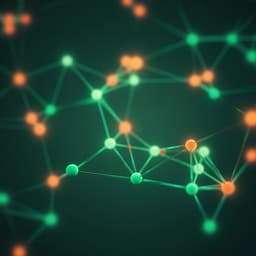
Veterinary Science
Analyses of canine cancer mutations and treatment outcomes using real-world clinico-genomics data of 2119 dogs
K. Wu, L. Rodrigues, et al.
This groundbreaking study by Kevin Wu and colleagues examines the striking parallels between canine and human cancers, unveiling key oncogenes and their potential in personalized oncology. With data from over 2,100 dogs, the research showcases how targeted treatments for humans may offer promising insights for canine models, paving the way for innovative drug discovery.
~3 min • Beginner • English
Introduction
The study addresses the need for complementary cancer models to accelerate translation of targeted therapies, given the slow pace and high failure rate of human clinical trials. Dogs develop spontaneous tumors that mirror human cancers in environment, histology, molecular targets, response, resistance, and genetics. With over 19,000 canine genes orthologous to human genes and strong sequence similarity, canine cancers provide a relevant comparative model. Although genomic similarities and shared driver mutations between canine and human tumors are well documented, there remains a knowledge gap linking specific gene alterations to prognosis and treatment response in canines. Leveraging increased attention to canine cancer care and next-generation sequencing in veterinary practice, the purpose of this study is to systematically characterize the prognostic effects of tumor types and somatic mutations, and to evaluate associations between targeted therapies and outcomes in dogs, thereby informing precision oncology and human drug development.
Literature Review
Methodology
Study population and data collection: Client-owned dogs with confirmed cancer diagnoses were enrolled in the FidoCure Precision Medicine Platform (May 2019–March 2022) by over 200 veterinarians. Of 2702 enrolled cases, 2144 had demographics and overall survival times; 2119 had annotated tumor types. FFPE tumor tissue was available for 1108 dogs for NGS; 792 dogs also had targeted treatment information. The study was approved by The One Health Company animal care and ethics committee.
Targeted therapies: Veterinarians had access to 10 human FDA-approved targeted therapies for off-label canine use: imatinib, lapatinib, rapamycin (sirolimus), sorafenib, trametinib, vorinostat, dasatinib, toceranib, palbociclib, and olaparib. Treatments were typically given orally at home; clinical updates and outcomes were collected by FidoCure staff.
Sequencing panel and laboratory methods: A targeted NGS panel assessed coding exons of 48 oncogenes/tumor suppressors prioritized for relevance to human and canine cancers and availability of targeted drugs (genes list includes ABL1, ALK, ARID1A, ATM, ATRX, BRAF, BRCA1, BRCA2, EGFR, ERBB2, KIT, KRAS, NRAS, PIK3CA, PTEN, TP53, etc.). Hybrid capture was performed using Agilent SureSelect custom probes and SureSelect XT. Libraries were quantified by qPCR and sequenced on Illumina platforms (150 bp paired-end; up to 6M PE reads) achieving ~612× coverage per sample. Reads were aligned to CanFam3.1/CanFam4 with BWA-MEM; processing utilized GATK (AddOrReplaceReadGroup, MarkDuplicates, RealignerTargetCreator, IndelRealigner) with minimum mapping and base quality 10; BamTools filtered low-quality reads (mapping quality <5; high mismatch rate). No matched normals were used; germline/somatic classification followed a previously published pipeline. Primary analyses excluded germline variants; a secondary analysis including germline variants was also performed (Supplementary).
Outcomes and feature processing: Two survival endpoints were computed: (1) overall survival from diagnosis and (2) survival from treatment (start = first targeted therapy order). Dogs were censored at last known update if alive; deaths required a reported date. Treatments, tumor types (19 categories), and gene mutations were one-hot encoded. Demographics used as covariates: weight (kg), sex, reproductive status (neutered/spayed vs intact), age at diagnosis, and time from diagnosis to treatment. During modeling, highly correlated covariates were removed to mitigate multicollinearity; low-sample-size gene strata (p>n) were excluded. Grouping rare genomic alterations by pathways did not yield additional significant signals.
Statistical models: Survival analyses used Cox proportional-hazards models (lifelines in Python). Tumor type effects on survival from diagnosis were modeled with one tumor-type indicator at a time, controlling for weight, sex, reproductive status, age at diagnosis, and time from diagnosis to treatment. Gene-level mutation effects on survival from diagnosis were modeled with a binary indicator for each gene’s mutation status, controlling for demographics and tumor type. Treatment effects were modeled within mutation-defined subcohorts, analyzing survival from treatment as a function of demographics, time to treatment, one-hot treatments (10), and tumor types (19). Hazard ratios (HR) with 95% CIs and p-values were reported; Kaplan–Meier curves with 95% CIs were provided in Supplementary.
Key Findings
Dataset summary: Of 2702 total cases, 2144 had demographics and survival; 2119 had tumor types; 1108 had high-quality tumor sequencing; 792 had targeted treatment information. Across sequenced cases, mutations spanned 48 targeted genes with an average of 2.4 mutated genes per dog; 10 targeted therapies were administered.
Tumor type prognosis (survival from diagnosis; Cox models with demographic controls): Nine of 19 tumor categories showed significant associations. Examples (HR>1 indicates higher risk):
- Hemangiosarcoma: HR 2.07 (95% CI 1.79–2.38), p<0.01; n=405 vs 1714; median survival 203 vs 421 days.
- GI carcinoma: HR 1.96 (1.15–3.34), p=0.01; n=25 vs 2094; median 204 vs 370 days.
- Histiocytic sarcoma: HR 1.55 (1.14–2.10), p=0.01; n=73 vs 2046; median 211 vs 373 days.
- Lymphoma: HR 1.47 (1.08–1.99), p=0.01; n=59 vs 2060; median 298 vs 372 days.
- Osteosarcoma: HR 1.40 (1.10–1.79), p=0.01; n=152 vs 1967; median 256 vs 377 days.
Protective associations (HR<1):
- Melanoma: HR 0.74 (0.57–0.97), p=0.03; n=117 vs 2002; median 379 vs 366 days.
- Soft tissue sarcoma: HR 0.64 (0.52–0.79), p<0.01; n=220 vs 1899; median 506 vs 353 days.
- Anal sac carcinoma: HR 0.39 (0.27–0.55), p<0.01; n=87 vs 2032; median 812 vs 349 days.
- Thyroid carcinoma: HR 0.35 (0.17–0.69), p<0.01; n=28 vs 2091; median 1007 vs 365 days.
Gene-level mutation prognosis (survival from diagnosis; controlling for demographics and tumor types): Five genes showed significant associations:
- TP53 mutated: HR 1.48 (1.24–1.77), p<0.01; n=379 vs 711; median 220 vs 420 days.
- PIK3CA mutated: HR 1.33 (1.03–1.72), p=0.03; n=129 vs 979; median 189 vs 370 days.
- NRAS mutated: HR 0.60 (0.41–0.88), p<0.01; n=69 vs 1039; median 342 vs 350 days.
- ATM mutated: HR 0.51 (0.32–0.79), p=0.01; n=58 vs 1050; median 809 vs 343 days.
- KIT mutated: HR 0.43 (0.21–0.88), p=0.02; n=31 vs 1077; median 642 vs 344 days.
Treatment effects within mutation-defined subcohorts (survival from treatment; controlling for demographics and tumor type): Three significant gene–drug associations (HR<1):
- BRCA1 (deleterious/unknown; germline and somatic included): Dasatinib HR 0.26 (0.08–0.82), p=0.02; n=11 vs 85; median 284 vs 183 days.
- BRAF mutated: Lapatinib HR 0.10 (0.02–0.65), p=0.02; n=24 vs 21; median 641 vs 202 days.
- ARID1A mutated: Trametinib HR 0.08 (0.01–0.69), p=0.02; n=18 vs 20; median 237 vs 185 days.
Sensitivity including germline variants: Results were broadly consistent with somatic-only analysis; notable finding was ALK mutations associated with improved survival (median 424 vs 349 days; HR 0.64 [0.42–0.97], p=0.04). Overall, germline inclusion increased patient count by 6.5% and did not materially alter major conclusions.
Comparative insights: Concordant prognostic effects between canine and human cancers were observed for TP53, ATM, and KIT; differences for PIK3CA and NRAS likely reflect the high prevalence of hemangiosarcoma in dogs (19% of cohort) and its associated risk.
Discussion
The study demonstrates that real-world clinico-genomic data from dogs with spontaneous tumors can elucidate prognostic effects of tumor types and specific somatic alterations and can identify mutation-conditioned treatment associations. Significant HRs for TP53, ATM, KIT, PIK3CA, and NRAS align partially with human pan-cancer findings, supporting cross-species concordance for key oncogenes (e.g., TP53’s association with worse outcomes). Divergences for PIK3CA and NRAS likely stem from species-specific tumor prevalence, particularly the overrepresentation of hemangiosarcoma in canines, which carries higher risk and is enriched for these mutations. Treatment-response modeling within mutation-defined subcohorts identified promising gene–drug signals (e.g., BRAF–lapatinib, ARID1A–trametinib, BRCA1–dasatinib) suggesting that targeted therapies developed for humans may improve outcomes in genomically selected canine patients. These findings support the utility of canine models for hypothesis generation and prioritization in human precision oncology. Translational considerations include similarities in pharmacokinetics and toxicities across species for the evaluated drugs and the potential to use canine data to inform drug development pipelines while acknowledging dosing differences. Overall, integrating genomic profiles with real-world outcomes in dogs addresses the research questions by quantifying mutation- and treatment-associated risks and highlighting areas of human–canine concordance and divergence.
Conclusion
Using the largest clinico-genomic canine cancer dataset to date, this study systematically links tumor types and somatic mutations to prognosis and identifies mutation-conditioned associations with targeted therapies in dogs. The work underscores strong cross-species concordance for several oncogenes (e.g., TP53, ATM, KIT) and reveals promising therapeutic signals (e.g., lapatinib in BRAF-mutant tumors, trametinib in ARID1A-mutant tumors, dasatinib in BRCA1-altered tumors). These results lay a foundation for leveraging spontaneous canine tumors to accelerate hypothesis generation and drug discovery in human precision oncology. Future work should expand sample sizes to enable robust tumor type–gene interaction analyses, refine dosing translations between species, incorporate additional molecular data types (e.g., copy number, RNA), and prospectively validate identified gene–drug associations in controlled comparative studies.
Limitations
Key limitations include differences in tumor type distributions between canine and human cohorts (e.g., hemangiosarcoma and urothelial carcinomas overrepresented in dogs; breast, prostate, lung underrepresented), which affect cross-species comparability and contribute to observed divergences (e.g., PIK3CA, NRAS). Sample size constraints limited power to assess tumor type–gene mutation interactions with statistical significance. Multicollinearity required removal of correlated covariates, and some low-frequency gene strata were excluded (p>n). Sequencing lacked matched normal samples; although a pipeline was used to distinguish germline from somatic variants and primary analyses excluded germline, residual misclassification cannot be fully excluded. Real-world treatment regimens (including combination use and variable dosing) and differences in dosing/toxicity between species may confound treatment-effect estimates. Outcome ascertainment relied on veterinary reports, with potential censoring and reporting biases.
Related Publications
Explore these studies to deepen your understanding of the subject.







